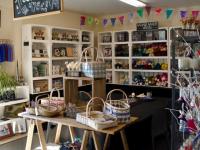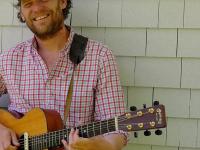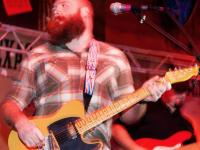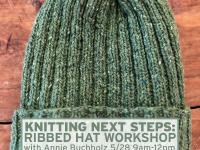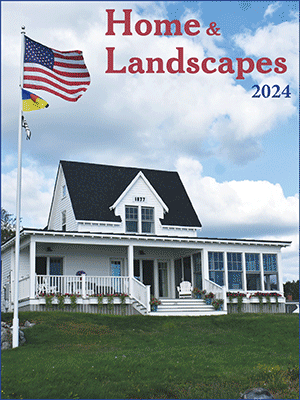The Upper Pogie Factory at Linekin, part I
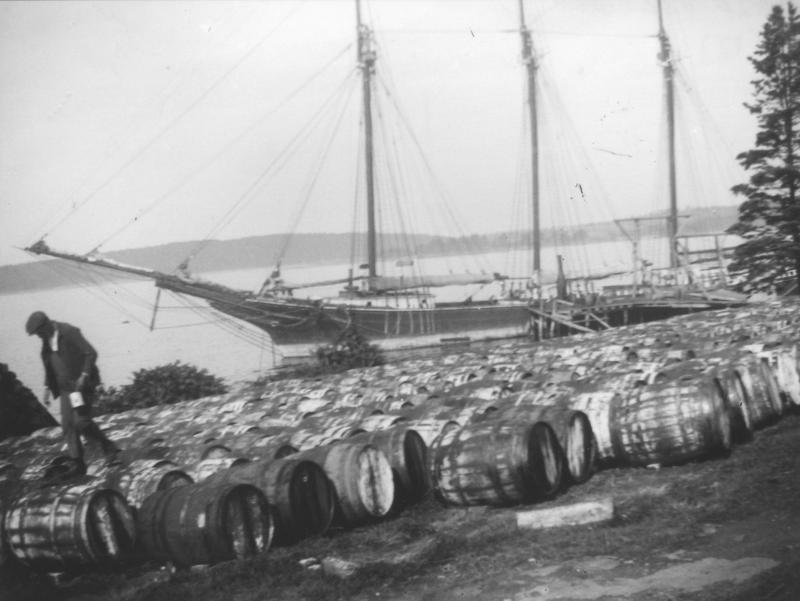 This west-looking view from the Paul Luke property at Linekin shows bookkeeper Jainus Jones counting barrels of oil produced from the fish. They are soon to go aboard the three-masted schooner that is tied up. The main elevated wharf that received fish was further south. The photo is said to have been taken in 1881, but the early 1880s were hard times in the pogie fishery. Maybe the 1890s would be a better guess. Courtesy of the Boothbay Region Historical Society
This west-looking view from the Paul Luke property at Linekin shows bookkeeper Jainus Jones counting barrels of oil produced from the fish. They are soon to go aboard the three-masted schooner that is tied up. The main elevated wharf that received fish was further south. The photo is said to have been taken in 1881, but the early 1880s were hard times in the pogie fishery. Maybe the 1890s would be a better guess. Courtesy of the Boothbay Region Historical Society
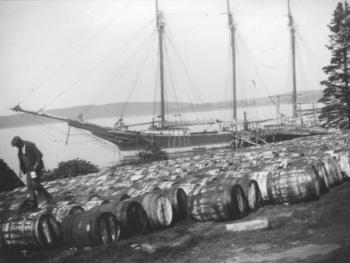 This west-looking view from the Paul Luke property at Linekin shows bookkeeper Jainus Jones counting barrels of oil produced from the fish. They are soon to go aboard the three-masted schooner that is tied up. The main elevated wharf that received fish was further south. The photo is said to have been taken in 1881, but the early 1880s were hard times in the pogie fishery. Maybe the 1890s would be a better guess. Courtesy of the Boothbay Region Historical Society
This west-looking view from the Paul Luke property at Linekin shows bookkeeper Jainus Jones counting barrels of oil produced from the fish. They are soon to go aboard the three-masted schooner that is tied up. The main elevated wharf that received fish was further south. The photo is said to have been taken in 1881, but the early 1880s were hard times in the pogie fishery. Maybe the 1890s would be a better guess. Courtesy of the Boothbay Region Historical Society
Though I had visited the historical society infrequently at a couple of its locations before 1985, I hadn't been interested in helping out, nor had I the time as a young mother. But in 1985, my eighth-grade son, Keith Hartford, had a "Boothbay Project" assignment which took us there. That project did a lot of good for local history, and the society has many of the school papers, some very well done.
Keith chose as his subject the pogie factory that had been on our property at Linekin, next south from Paul Luke's shipyard; it also occupied the factory site. Any digging on our property brought up bricks, coal ash and clinkers, and occasionally reeking pockets of fish scrap where some some had been buried. To satisfy our curiosity and his assignment, Keith and I went to the museum on Oak Street where Alden Stickney told us they had secondary sources profiling the pogie industry generally, but nothing on the specific factory and to please bring in any info we gathered. During our visit Alden said they always needed volunteers, and I started helping out a few months later.
Pogie the fish and the process
As background, pogies (aka pogy, menhaden) are an oily fish that travel in vast schools; some schools stretched for a mile before man industrialized their killing. The schools traveled from Florida to Nova Scotia, just as the mackerel did along the coast from June to October. Pogies are able to suffocate themselves by exhausting the oxygen in a cove's seawater since they tend to crowd into coves and bays. Many remember the pogies' suffocating in coves here in the 1980s. The fish were prized for mundane reasons: oil extracted for paint manufacture and lighting fuel, and the remains for fertilizer after the oil was pressed out. People do/did eat them but not much; J. C. Poole, who had a fish business on the site of Fisherman's Wharf, bought pogies to ship as food to St. Louis in 1888. So there's one mention. Problems: pogie were oily, bony, and were said to have a "foul" taste.
Mainers were unfamiliar with the process needed to turn a profit from schools of pogies, so they relied on methods developed in Rhode Island to get into the business. The first nearby pogie factory was built at South Bristol in 1864, beating us by two years. Many huge plants opened in Boothbay in 1866 and after, and they did very well. The Churches of Tiverton, Rhode Island were big players here, at least on our property. All factories, mammoth in size, were owned by out-of-town or out-of-state interests since local capital was too limited for the necessary structures and investment.
The first step for a pogie factory was to supply it with fish by sending out its pogie vessels, whether schooners or steamers, and find the schools nearby. In the case of the nearby pogie schools, they ended up at the local factories. A conveyor belt brought them from the vessel wharves to huge factory vats where they were cooked. Steam power was necessary, hence the needs for coal and water. There was always a freshwater pond nearby to supply steam. After cooking, steam pressure pressed the oil out at 100 tons per square inch; next the oil was drained into barrels. Finally, the remaining chum and fish scraps were dried on wooden platforms and used as bait or fertilizer. Some glue could be produced as well.
The help
With the museum of limited help, we went further afield to neighbors at Linekin and East Boothbay. Three local men helped my son: Pete Jones, born 1899, whose father Jainus was the factory bookkeeper; Winfield Dodge, born 1909, who had a long Linekin memory; and Bobby Holbrook, born 1942, who was very knowledgeable about Linekin history. Pete himself had worked for the plant, cleaning barrels for two cents each (boys routinely worked if they could). Winfield explained that our factory was the "upper factory" to Linekin people; the one at Tibbetts Cove was the "lower factory."
A local name for Linekin's Tibbetts Cove was the Lower Elbow, while Linekin's Upper Elbow was renamed Smugglers Cove when the motel was built there, I suppose to attract guests. The upper ("our") pogie factory was a third of a mile above the Upper Elbow. There were more factories elsewhere, such as one at Ocean Point and two on the Wilde land at Linekin, almost all strung from Ocean Point along Linekin to Perch Island Cove. Our factory was built in 1866.
Event Date
Address
United States













